Zinziberis Siccum, Dry Ginger, Gan Jiang 干姜Gan Jiang (TCM)Shunthi (Ayurveda) Chuku (Siddha) Zanjabil, Zanjabeel Khushk (Unani) Sman Sga སྨན་སྒ (Tibetan) |
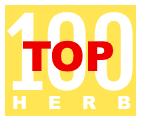
|
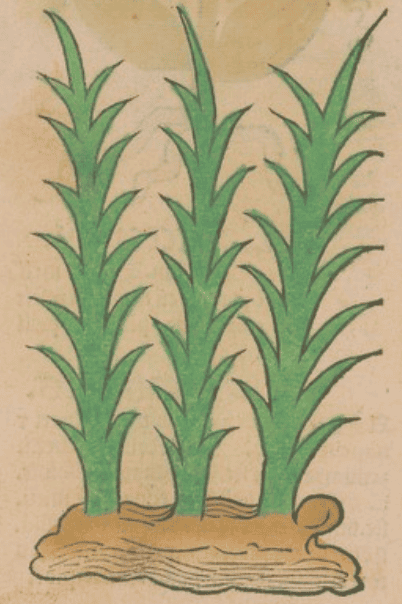
|
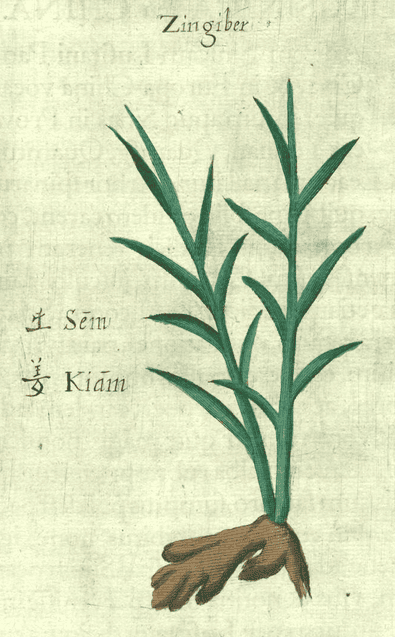
|
|
Ortus Sanitatis, Meydenbach, 1491 |
Flora Sinensis, Boym, 1653 |
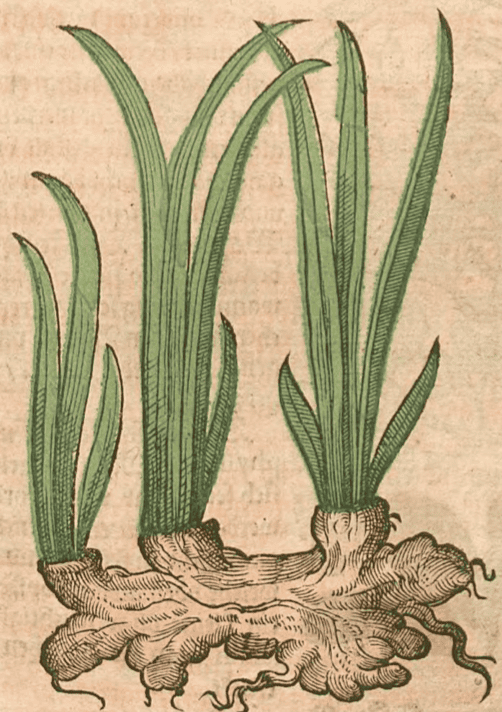
|
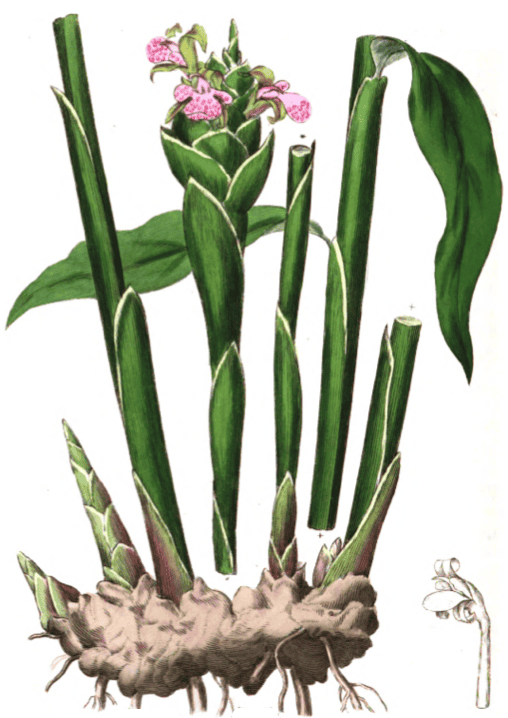
|
|
Krauterbuch, Lonitzer, 1578 |
Medical Botany, Woodville, Hooker, 1832 |
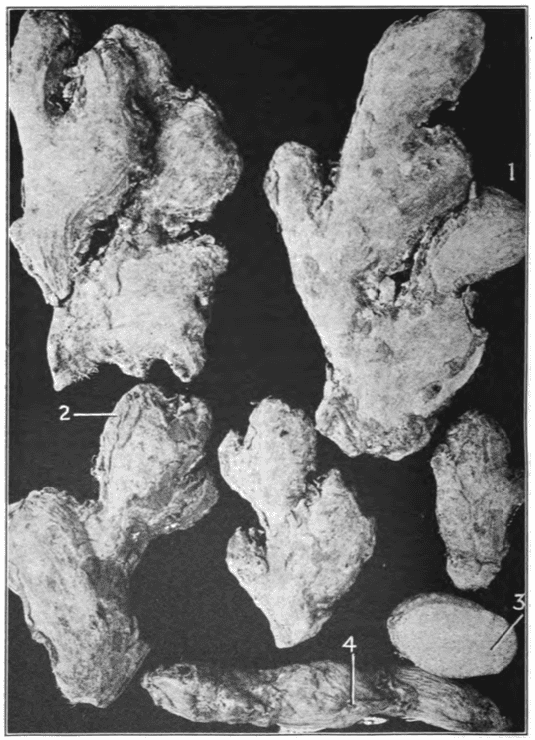
|
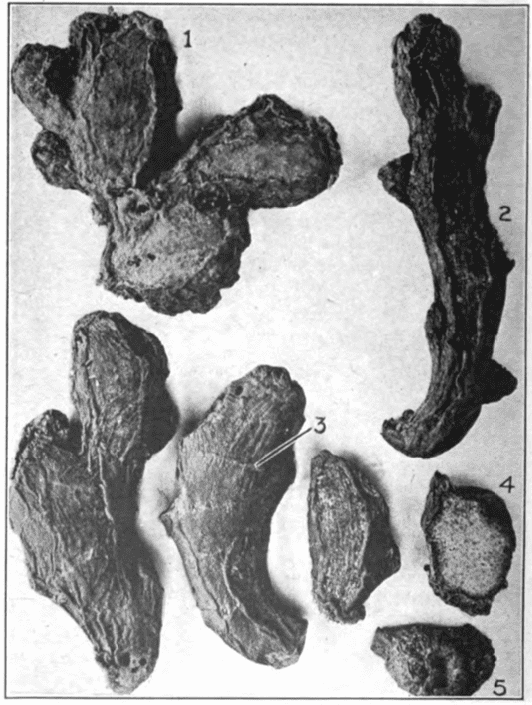
|
|
Chinese Ginger |
Culcutta Ginger |
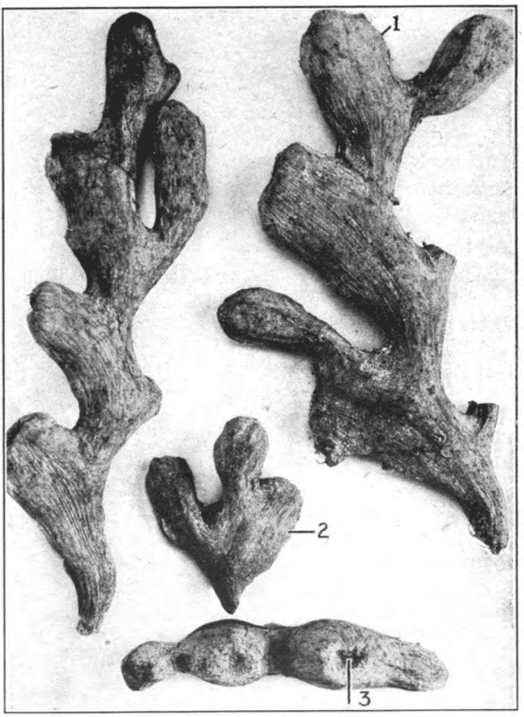
|
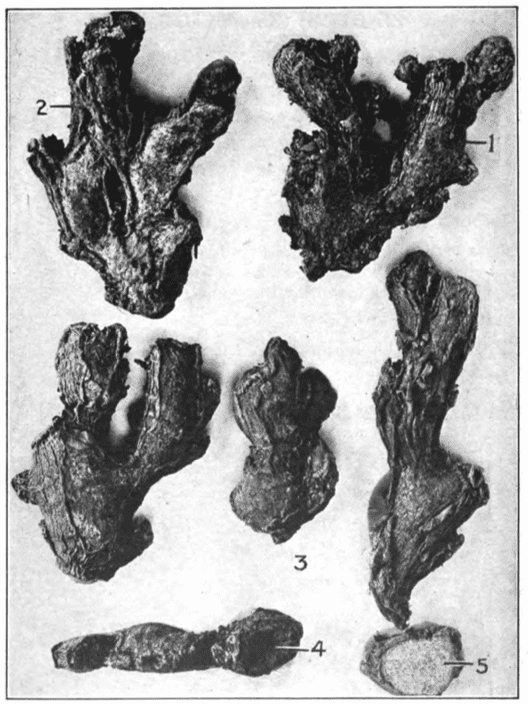
|
|
Jamaica Ginger |
African Ginger |
Botanical name:
Zingiber officinalis
Parts used:
Dry Rhizome
Temperature & Taste:
Hot, dry. Pungent
Classifications:
2B ATTENUATER. 2F. PURIFYING. 2H. CARMINATIVE.
3F. LITHONTRIPTIC. 3H. LACTAGOGUE. 3L. ANTI-TUSSIVE. 3P. MASTICATORIES & STERNUTATORIES.
3K. EXPECTORANT
3I. APHRODISIAC. 3J. INCREASE SEMEN (candied Ginger)
4e. STOMACHIC. 4g. HEPATIC. 4h. NEPHRITIC
TCM:
M. Warm to Clear Cold
Uses:
1. Warms the Yang, Clears Cold: (West, TCM, Ayurveda, Tibetan)
-poor circulation due to coldness, or lack of body heat; coldness of the limbs, weak pulse
-poor circulation, chilblains, cramp, fibrositis and muscle strain.
-impotence from cold (Ginger with Honey, or Candied Ginger); and to stimulate erection
-poor Heart function from Cold manifesting as Palpitations.
-Amenorrhoea and Dysmenorrhea from cold
-exhaustion during or after Childbirth.
-‘Profitable for the Old’.
-Muscle and Joint pain; Rheumatic and Arthritic pains and swellings
-Diabetes; Hypoglycemia, and to lower Cholesterol.
2. Warms the Stomach, Promotes Digestion: (West, TCM, Ayurveda, Tibetan)
-‘strengthens and fortifies the stomach’ (Galen)
-vomiting, diarrhea, abdominal pain, dyspepsia, flatulence, colic from Cold
-nausea from cold: motion sickness, morning sickness, nausea related to flus or virus, nausea from medication etc.
-Gastric Ulcers
3. Warms the Lungs, Clears Cold Phlegm: (West, TCM, Ayurveda, Tibetan)
-Lung conditions from cold-type phlegm (TCM, West)
-Cough, Wheezing
4. Clears Wind and Phlegm, Clears the Sight:
-traditionally used for Headaches, Vertigo and Dizziness the latter 2 of which have been confirmed in modern trials.
-Unani texts list it for Wind diseases while Ayurvedic texts state it regulates Wind
-Paralysis, Sciatica, Migraine (Unani)
-‘effectually oppose itself against all Darkness of Sight’ (Gerard)
-‘increases Intelligence’ (Mahadevadeva, Unani)
-used as snuff to cause sneezing which clears the head.
5. Clears Cold, Stops Bleeding: (TCM)
-chronic bleeding from coldness; pale face and tongue, weak and thin pulse, coldness of the limbs, blood is pale and thin looking.
-especially suitable for Uterine bleeding. (Burnt Ginger is most often used)
Dose:
Dry Ginger: in decoction: 3–9 grams;
Powder: 500mg–3 grams
Comment:
1. Fresh Ginger is more tempered in its Heat and works more superficially, promoting Sweat and clearing Cold from the surface of the body in Cold and Flu. It is also very good to promote digestion and enhance assimilation and is beneficially used in cooking for this purpose.
2. Dry Ginger is Hot and works deeper in the body, especially the Spleen and Kidneys. It warms the Yang and is stronger for Internal Cold.
3. In practice, the distinction between fresh and Dry Ginger is more prominent in TCM. For example, Ayurveda will commonly apply Dry Ginger to acute Cold and Flu and fresh or Candied Ginger can be used to Warm the Kidney Yang. Likewise TCM will prefer carbonised Ginger for Cold-type Bleeding but we can see evidence of Dry Ginger being used for this purpose without being carbonised.
4. Candied (or Conserved) Ginger is Warm and Sweet. It increases Yang and is useful for Impotence and is traditionally regarded as Aphrodisiac. It warms and strengthens a Cold Stomach.
5. Ginger Skin clears Water and is useful in Edema and Fluid retention from Cold and Damp.
6. Carbonised Ginger is more effective to stop Cold-type Bleeding, especially Uterine Bleeding.
Correctives:
1. Honey
2. Licorice
3. Almond oil (Ayurveda)
4. Camphor (Unani)
Substitute:
1. Fresh and Dried Ginger are the best substitutes for one another according to Unani physicians.
2. Black Pepper (Unani)
3. Galangal
4. Hedichium spicatum is used as a substitute in Tibetan Medicine (Buryat region)
5. “The substitute of dried Ginger is Pellitory [Pyrethrum].” (Avicenna)
Preparation:
1. Quick-Fried Ginger Pao Jiang
Dry Ginger is stir-fried in a hot dry wok until it is fragrant and slightly scorched.
This is better for Bleeding from Cold, and lower abdominal cold and pain.
Main Combinations:
-Ginger with Long and Black Pepper (Trikatu)
Often combined with Long and/or Black Pepper; the three together form Trikatu (‘Three Pungents’) of Ayurveda. Used to clear cold, resolve Damp, promote digestion and increase assimilation and bio-availability. They are often added to formulas of Traditional Medicine.
1. Ginger Pills: Combine Ginger powder and Ginger juice to form pills. Good to clear Cold, warm the Stomach, increase circulation; for Cold, Flu, Headache, Joint pain etc. (Ayurveda)
2. Acute Cold or Flu from Wind-Cold:
i. Ginger, with Cinnamon, Lemongrass (Ayurveda)
ii. as a Diaphoretic, Ginger with Long and Black Pepper, Cardamon, Grains of Paradise, Camphor (as in Diaphoretic Specific of Paracelsus)
3. Cold Phlegm:
i. Ginger with Mastic and Turbith (as in Powder of Turbith of Avicenna)
ii. Ginger with Mastic, Aniseed, Turbith (as in Compound of Turbith with Anise)
iii. Ginger with Agaric, Chebulic Myrobalan, Turbith, Aniseed, Mastic, Clove, Cinnamon (as in Infusion to Purge Phlegm more Compound of Mesue)
4. Cold Cough:
i, Ginger with Elecampane, Licorice, Aniseed
ii. Ginger with Adhatoda, Long Pepper (Ayurveda)
5. Fever, Indigestion, Diarrhea, Bronchitis, Ginger with Black and Long Pepper, Clove, Nutmeg (as in Powder of Clove, of Ayurveda)
6. Poor digestion, Nausea, Vomiting, Cough, Asthma, Ginger with Long and Black Pepper, Indian Spikenard, Clove, Nutmeg, Cinnamon, Camphor (as in Powder of Camphor or Ayurveda)
7. Diarrhea:
i. Ginger with Tormentil, Galangal, Mastic (as in Decoction of Tormentil)
ii. Ginger with Tormentil, Galangal, Marshmallow (as in Powder of Tormentil Compound)
8. To warm and strengthen the Stomach:
i. Ginger with Galangal, Clove, Cinnamon, Cardamon, Indian Spikenard, Pine nut, Pistachio, Aniseed, Licorice, Saffron (as in Diazingiber of Nicholas)
ii. Ginger with Calamus and Orange peel
iii. Candied Ginger, Extract of Juniper (½ oz. each), Conserve of Roses, candied Lemon peel (2 oz. each), Cinnamon, Nutmeg (1 ½ drams each), with Syrup of Quince, form an Electuary. Take 2 drams after meals to strengthen Digestion. (A Treatise on Foreign Drugs, Geoffroy and Thicknesse, 1749)
iv. Ginger with Cardamon, Cinnamon, Clove, Nutmeg, Saffron (as in Electuary of Ginger, Unani)
9. Poor appetite during Pregnancy, Ginger with Long Pepper, Cumin and Celery seed, as a powder with Honey (Ayurveda)
10. Morning Sickness, Ginger with Coriander seed, Cyperus rotundus
11. Coldness of the Heart, Heart congestion, poor circulation:
i. Ginger with Bdellium, Arjuna
ii. Ginger, Frankincense, Saffron, Rose
12. Dizziness, Vertigo, Ginger with Peony, Nutmeg, Mistletoe, Galangal, Long Pepper, Tormenti, Rosemary (as in Powder for Dizziness and Vertigo)
13. Arthritis:
i. Ginger with Clove, Costus, Elecampane, Cumin, Colchicum (as in Electuary of Clove and Costus)
14. Dysmenorrhea: Ginger, Turmeric, Rose (Ayurveda)
15. Promote sperm production in cold bodies, Ginger, Cinnamon, Nutmeg
16. Against Poison: Ginger with Saffron, Cinnamon, Costus, Schoenanth, Frankincense (as in Powder for Mortal Poison)
17. Scoliosis and crookedness of the Spine, Confected Ginger with Calamus, Betony, Bdellium, Stoechas, Rue, Artichoke root, Licorice (Wizrtung)
Major Formulas:
Electuary of Ginger (Dia Zingiber) (Nicholas)
Infusion to Purge Phlegm more Compound of Mesue
Decoction of Tormentil
Powder of Turbith (Avicenna)
Compound of Turbith with Anise
Powder of Senna (Montagna)
Powder of Three Peppers (Diatrion Piperion) (Mesue)
Powder of Tormentil Compound
The Powder of Trithemius
Powder for Dizziness and Vertigo
Powder for Melancholy (Philon)
Powder to Purge Phlegm (Unani)
Emperors Powder
Species Incisa (Augustine Pharmacopoeia)
Antidote for Wind and Cold (Nicholas)
Antidotum Augustini (Nicholas)
Electuary of Aloeswood of Avicenna
Electuary of Clove and Costus
Pluchea and Bdellium Pills (Rasna Guggulu) (Ayurveda)
Eight-Limbed Electuary (Ayurveda)
Powder of Clove (Ayurveda)
Powder of Camphor (Ayurveda)
Cardamon 10 (Sug smel bcu pa) (Tibetan Medicine)
Ban Xia Xie Xin Tang
Fu Zi Li Zhong Wan
Gan Cao Gan Jiang Tang
Gan Jiang Huang Qin Huang Lian Ren Shen Tang
Gui Zhi Ren Shen Tang
Li Zhong Wan
Shao Fu Zhu Yu Tang
Shi Wei Bai Du San
Si Ni Tang
Wen Pi Tang
Xiao Qing Long Tang
Zheng Qi Tian Xiang San
Cautions:
1. Dry Ginger should be avoided in cases with Heat and Yin Deficiency.
2. Limit dose to 2–3 grams of dry Ginger during Pregnancy or in bleeding disorders.
3. ‘it ought not to be given in a large Dose to Melancholics; because it renders the melancholic Humours thicker, more fixed, and sometimes, says Herman, altogether immovable.’ (A Treatise on Foreign Drugs, Geoffroy and Thicknesse, 1749)
Main Preparations used:
Candied Ginger, Green Ginger
-
Extra Info
- History
-
Research
|
‘Ginger is known in India under the old name of Sringavera, derived possibly from the Greek [?]. As a spice it was used among the Greeks and Romans, who appear to have received it by way of the Red Sea, inasmuch as they considered it to be a production of Southern Arabia. In the list of imports from the Red Sea into Alexandria, which in the second century of our era were there liable to the Roman fiscal duty (vectigal), Zingiber occurs among other Indian spices. During the middle ages it is frequently mentioned in similar lists, and evidently constituted an important item in the commercial relations between Europe and the East. Ginger thus appears in the tariff of duties levied at Acre in Palestine about A.D. 1173; in that of Barcelona in 1221; Marseilles in 1228; and Paris in 1290. The Tarif des Peages, or customs tariff, of the Counts of Provence in the middle of the 13th century, provides for the levying of duty at the towns of Aix, Digne, Valensole, Tarascon, Avignon, Orgon, Aries, &c, on various commodities imported from the East. These included spices, as pepper, ginger, cloves, zedoary, galangal, cubebs, saffron, canella, cumin, anise; dye stuffs, such as lac, indigo, Brazil wood, and especially alum from Castilia and Volcano; and groceries, as racalicia (liquorice), sugar and dates. In England ginger must have been tolerably well known even prior to the Norman Conquest, for it is frequently named in the Anglo- Saxon leech-books of the 11th century, as well as in the Welsh “Physicians of Myddvai“. During the 13th and 14th centuries it was, next to pepper, the commonest of spices, costing on an average nearly 1s. 7d. per lb., or about the price of a sheep. |
The merchants of Italy,about the middle of the 14th century, knew three kinds of ginger, called respectively Belledi, Colombino, and Micchino. These terms may be explained thus:–Belledi or Baladi is an Arabic word, which, as applied to ginger, would signify country or wild, i.e. common ginger. Colombino refers to Columbum, Kolamor Quilon, a port in Travancore frequently mentioned in the middle ages. Ginger termed Micchino denotes that the spice had been brought from or by way of Mecca. Ginger preserved in syrup, and sometimes called Green Ginger, was also imported during the middle ages, and regarded as a delicacy of the choicest kind. The plant affording ginger must have been known to Marco Polo (circa 1280-90), who speaks of observing it both in China and India. John of Montecorvino, who visited India about 1292, describes ginger as a plant like a flag, the root of which can be dug up and transported. Nicolo Conti also gave some description of the plant and of the collection of the root, as witnessed by him in India. The Venetians received ginger by way of Egypt; yet some of the superior kinds were conveyed from India overland by the Black Sea, as stated by Marino Sanudo about 1306. Ginger was introduced into America by Francisco de Mendoca, who took it from the East Indies to New Spain. It was shipped for commercial purposes from the Island of St. Domingo as early at least as 1585; and from Barbados in 1654. According to Renny, 22,053 cwt. were exported from the West Indies to Spain in 1547. (Pharmacographia, Fluckiger & Hanbury, 1879) |
–Zingiber officinale var. rubrum: Red Ginger’s Medicinal Uses.
–Ginger: a systematic review of clinical trials and recent advances in encapsulation of its bioactive compounds.
–Zingiberis Rhizoma Recens: A Review of Its Traditional Uses, Phytochemistry, Pharmacology, and Toxicology.
–A recent update on the multifaceted health benefits associated with ginger and its bioactive components.
–Ginger (Zingiber officinale Rosc.) and its bioactive components are potential resources for health beneficial agents.
–Nutritional implications of ginger: chemistry, biological activities and signaling pathways.
ANTIFUNGAL
–Fungicidal properties of ginger (Zingiber officinale) essential oils against Phytophthora colocasiae.
–Antifungal and antimycotoxigenic effects of Zingiber officinale, Cinnamomum zeylanicum and Cymbopogon martinii essential oils against Fusarium verticillioides.
ANTI-VIRAL
–Antiviral Potential of Selected Medicinal Herbs and Their Isolated Natural Products.
–Is Trikatu; an ayurvedic formulation effective for the management of flu-like illness? A narrative review.
ANTIOXIDANT
–[Antioxidative effect of Chinese drugs].
–Antioxidant effects of Emblica officinalis and Zingiber officinalis on arsenic and lead induced toxicity on Albino rats.
–Comparative Study of Chemical Composition and Antioxidant Activity of Essential Oils and Crude Extracts of Four Characteristic Zingiberaceae Herbs.
ANALGESIC
–Ginger (Zingiber officinale Roscoe) as a nutraceutical: Focus on the metabolic, analgesic, and antiinflammatory effects.
ANTITOXIN
–Promising effects of gingerol against toxins: A review article
–Antioxidant effects of Emblica officinalis and Zingiber officinalis on arsenic and lead induced toxicity on Albino rats.
ANTIFIBROTIC
–Antifibrotic effect of Gancao Ganjiang decoction is mediated by PD-1 / TGF-β1 / IL-17A pathway in bleomycin-induced idiopathic pulmonary fibrosis.
CARDIOVASCULAR DISEASE
–Ginger: A complementary approach for management of cardiovascular diseases.
–Vasculoprotective effects of ginger (Zingiber officinale Roscoe) and underlying molecular mechanisms.
CARDIOPROTECTIVE
–The effect of ginger (Zingiber officinale) feed on cardiac biomarker in medium-dose isoproterenol-induced myocardial toxicity.
–Ginger (Zingiber Officinale Roscoe) Extract Protects the Heart Against Inflammation and Fibrosis in Diabetic Rats.
ANTICONVULSANT
–6-Gingerol, a Major Constituent of Zingiber officinale Rhizoma, Exerts Anticonvulsant Activity in the Pentylenetetrazole-Induced Seizure Model in Larval Zebrafish.
ANTI-INFLAMMATORY
–Benefits of Ginger and Its Constituent 6-Shogaol in Inhibiting Inflammatory Processes.
ANTI-ALLERGY
–Ginger-derived compounds exert in vivo and in vitro anti-asthmatic effects by inhibiting the T-helper 2 cell-mediated allergic response.
ASTHMA
–Ginger-derived compounds exert in vivo and in vitro anti-asthmatic effects by inhibiting the T-helper 2 cell-mediated allergic response.
NAUSEA & VOMITING
–The Antiemetic Mechanisms of Gingerols against Chemotherapy-Induced Nausea and Vomiting.
MOTION SICKNESS
–Biochemical analysis reveals the systematic response of motion sickness mice to ginger (Zingiber officinale) extract’s amelioration effect.
–Clinical Evaluation of the Use of Ginger Extract in the Preventive Management of Motion Sickness.
OBESITY
–Ginger (Zingiber officinale) Attenuates Obesity and Adipose Tissue Remodeling in High-Fat Diet-Fed C57BL/6 Mice.
–Effects of Zingiber officinale extract supplementation on metabolic and genotoxic parameters in diet-induced obesity in mice.
INFLAMMATORY BOWEL DISEASE
–Ginger and its constituents: Role in treatment of inflammatory bowel disease.
ULCERATIVE COLITIS
–The Antiemetic Mechanisms of Gingerols against Chemotherapy-Induced Nausea and Vomiting.
HEPATOPROTECTIVE
–Ginger (Zingiber officinale Roscoe), Lemon (Citrus limon L.) Juices as Preventive Agents from Chronic Liver Damage Induced by CCl4: A Biochemical and Histological Study.
–Zingiber roseum Rosc. rhizome: A rich source of hepatoprotective polyphenols.
FATTY LIVER
–A systematic review and meta-analysis of preclinical and clinical studies on the efficacy of ginger for the treatment of fatty liver disease.
DIABETES
–Some Common Medicinal Plants with Antidiabetic Activity, Known and Available in Europe (A Mini-Review).
–Cardiometabolic effects of ZingiberOfficinale Roscoe extracts in Type 2 diabetic Cameroonians patients after six weeks of add-on Therapy : A single clinical-arm trial.
–Effectiveness of ginger in reducing metabolic levels in people with diabetes: a randomized clinical trial.
NEURODEGENERATION
–Potential Role of Ginger (Zingiber officinale Roscoe) in the Prevention of Neurodegenerative Diseases.
–Network pharmacology-based approach to investigate the mechanisms of Zingiber officinale Roscoe in the treatment of neurodegenerative diseases.
ANTIDEPRESSANT
–Antidepressant-like effect of dehydrozingerone from Zingiber officinale by elevating monoamines in brain: in silico and in vivo studies.
–Zingiber officinale Ethanolic Extract Attenuated Reserpine-Induced Depression-Like Condition and Associated Hippocampal Aberrations in Experimental Wistar Rats.
DEMENTIA / ALZHEIMER’S DISEASE
–Ginger, a Possible Candidate for the Treatment of Dementias?
–Zingiber officinale ameliorates Alzheimer’s disease and Cognitive Impairments: Lessons from preclinical studies.
ANTI-AGEING
–Identification of gingerenone A as a novel senolytic compound.
RHEUMATOID ARTHRITIS
–8-Shogaol inhibits rheumatoid arthritis through targeting TAK1.
–Zingerone (4-(four-hydroxy-3-methylphenyl) butane-two-1) modulates adjuvant-induced rheumatoid arthritis by regulating inflammatory cytokines and antioxidants.
EFFECTS ON SPERM
–A systematic review on the effect of Ginger (Zingiber officinale) on improvement of biological and fertility indices of sperm in laboratory animals, poultry and humans.
DYSMENORRHEA
–Efficacy of Ginger in the Treatment of Primary Dysmenorrhea: A Systematic Review and Meta-analysis.
ENDOMETRIOSIS
–Zingiber officinale Roscoe (Ginger) as a Complementary Option for Clinical Treatment of Endometriosis: An Experimental Study in Rats.
POSTPARTUM PAIN
–Effect of Zingiber officinale Roscoe rhizome (ginger) capsule on postpartum pain: Double-blind randomized clinical trial.
CANCER
–Functional properties of spice extracts obtained via supercritical fluid extraction.
–Mechanisms of Chemopreventive and Therapeutic Proprieties of Ginger Extracts in Cancer.
–Anti-Cancer Effect of Gingerol in Cancer Prevention and Treatment.
BREAST
–Gingerenone A Induces Antiproliferation and Senescence of Breast Cancer Cells.
–Preventive Effect of Combined Zingiber officinale and Terminalia chebula against DMBA-Induced Breast Cancer Rats via mTOR Inhibition.
CERVICAL
–Essential Oil from Zingiber ottensii Induces Human Cervical Cancer Cell Apoptosis and Inhibits MAPK and PI3K/AKT Signaling Cascades.
–Molecular and biological functions of gingerol as a natural effective therapeutic drug for cervical cancer.
–6-Shogaol from ginger shows anti-tumor effect in cervical carcinoma via PI3K/Akt/mTOR pathway.
COLORECTAL
–Evaluation of Antineoplasic Activity of Zingiber Officinale Essential Oil in the Colorectal Region of Wistar Rats.
GASTRIC
–Coptis chinensis and dried ginger herb combination inhibits gastric tumor growth by interfering with glucose metabolism via LDHA and SLC2A1.
LEUKEMIA
–A Novel Peptide Derived from Ginger Induces Apoptosis through the Modulation of p53, BAX, and BCL2 Expression in Leukemic Cell Lines.
PROSTATE
–Zingerone suppresses cell proliferation via inducing cellular apoptosis and inhibition of the PI3K/AKT/mTOR signaling pathway in human prostate cancer PC-3 cells.
